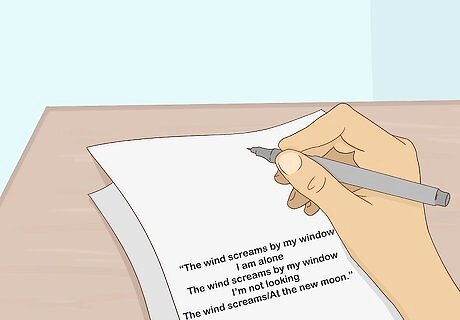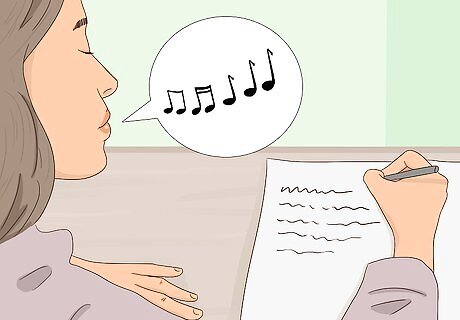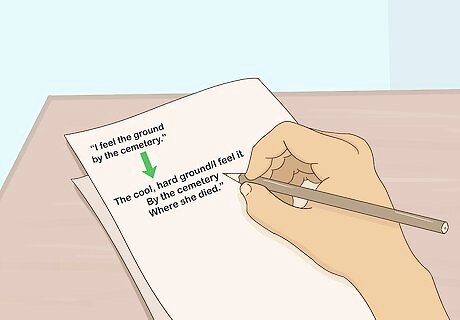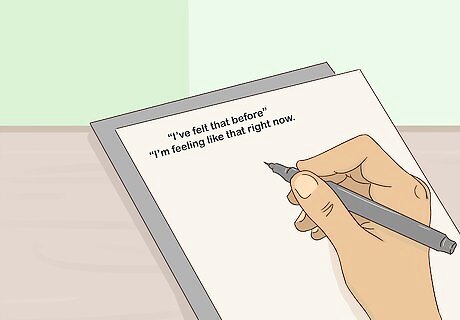
views
Meter and Structure

Create eight to twelve line verses. Songs are structured into verses, similar to stanzas in poetry. Most songs have verses that are eight to twelve lines long. The lines in verses are usually short, no longer than eight to ten words. Break up your poetry into verses so it better reflects the structure of a song. You may need to add or remove words from each line of your poetry to make them into verses. Be open to changing the lines of your poetry as needed to make them into song lyrics. When you are creating the verses, use lines in your poetry that are easy to follow and understand. You can also rearrange words or lines in your poetry to form a verse.

Compose a short, repetitive chorus. Most song lyrics will include a chorus, which is usually six to eight lines long. The chorus will repeat after each verse in the song. It should contain the central idea or meaning of the song. Take the words in your poetry and create a chorus for the song that is short and uses several words over and over again. For example, you may take a longer line in your poetry like, “The wind screams by my window and I am alone in my childhood bedroom, trying not to look at the new moon” and break it up to create a chorus: “The wind screams by my window/I am alone/The wind screams by my window/I’m not looking/The wind screams/At the new moon.” The chorus of the song will usually contain the title of the song. You may use the title of your poem as inspiration for the chorus of the song.

Decide whether or not your song lyrics will rhyme. Not all song lyrics rhyme. In fact, many modern songs have no rhyme scheme at all. Maybe you decide to avoid rhyme because you want the freedom to use whatever words you want. Or perhaps you want your song to rhyme so it is more catchy for your listeners. If you decide to include rhyme in your song lyrics, you may simplify the rhyme scheme in your poetry so it is more casual and easy to follow. For example, if you have a poem where every second line rhymes, you may adjust it so only the first and third lines rhyme or only the second and fourth lines rhyme. If you are composing rap lyrics, you may decide to stick to a couplet rhyming scheme, where every two lines rhyme in the song.

Listen to songs that have been written by poets. Many songwriters are also known as poets who have written or published poetry. Listen to their songs and read their song lyrics to get a better sense of how they combine poetry with music. You may listen to: “20th Century Schizoid Man” by King Crimson, which was co-written by poet Peter Sinfield. “Subterranean Homesick Blues” by Bob Dylan, who is considered a poet as well as a songwriter. “Blood on the Leaves” by Nina Simone, which is considered a song with poetic, powerful lyrics. “Big Yellow Taxi” by Joni Mitchell, who is considered a poetic singer-songwriter.
Language and Imagery

Make the language simple and casual. With song lyrics, you want to connect to your listeners by using language found in casual conversation. If your poetry uses formal language like “O my dear love” or “Long was I lost on the high seas,” strip it down to make it more simple and casual for your listeners. Pretend you are talking to a friend or family member in your song lyrics. For example, if you have a line in your poem like “Alone I felt in a sea of people,” you may adjust it to, “I felt alone in a sea of people” or “Just me in a sea of people.”

Use imagery that creates an emotional response. Keep any poetic imagery that will give the listener a sense of the speaker’s emotions and feelings. Make sure the imagery uses sensory details, such as what the speaker is seeing, touching, tasting, hearing, and smelling. For example, you may have a line in your poem like, “I feel the ground/by the cemetery.” You may then adjust the line for song lyrics and make it, “The cool, hard ground/I feel it/By the cemetery/Where she died.”

Include details that are universal for listeners. A good song will connect with your listeners and make them think, “I’ve felt that before” or “I’m feeling like that right now.” Use details from your poetry that feel universal and relatable for your listeners. For example, maybe you have a detail in your poetry about how it feels for you to lose your best friend. You may then include these details in a song about your relationship about your best friend, discussing the relationship from your perspective.

Tell your listener a story. A good song will take the listener on a journey and explore an experience or moment in a detailed way. There does not necessary have to be a clear beginning, middle, and end in a song, like in a book. Instead, the song should explore the thoughts and feelings of the speaker on a specific subject or idea. Pull lines out of your poetry that tell your listener a story from a particular perspective. For example, you may notice that your poetry often explores the recent birth of your brother. You may then pull lines out of your poetry to write a song that tells the story of the joyous day your brother was born.
Melody

Find a melody you connect with. Create an original melody on guitar. Add drums, keyboards, or strings to flesh out the melody. You can also use a melody that has already been made and is available for use online. Find a melody that you find interesting or catchy. You may also choose a melody that fits the mood or subject matter of your poetry. For example, if your poetry is about isolation and sadness, you may pick a melody that is just guitar on its own to create a lonely, isolated sound.

Sing your poetry aloud to the melody. Notice if certain lines do not fit or go well with the melody. Underline or highlight lines or words that seem to fit. Get a feel for how your poetry sounds when sung along to the melody. You may need to try singing a few different poems or lines of poetry to the melody to get a better sense of what works and what doesn’t. You may also need to sing the same lines of poetry several times to the melody to find the right rhythm. Be patient and have fun playing around with your words against the melody.

Adjust your poetry to fit the melody. Remove any words or phrases that sound clunky or awkward when sung along to the melody. Add words or phrases that complement or fit with the melody. Repeat words that sound good and seem to match the melody well. You can then start creating verses and a chorus for the song, making use the words match well with the melody you have chosen.



















Comments
0 comment